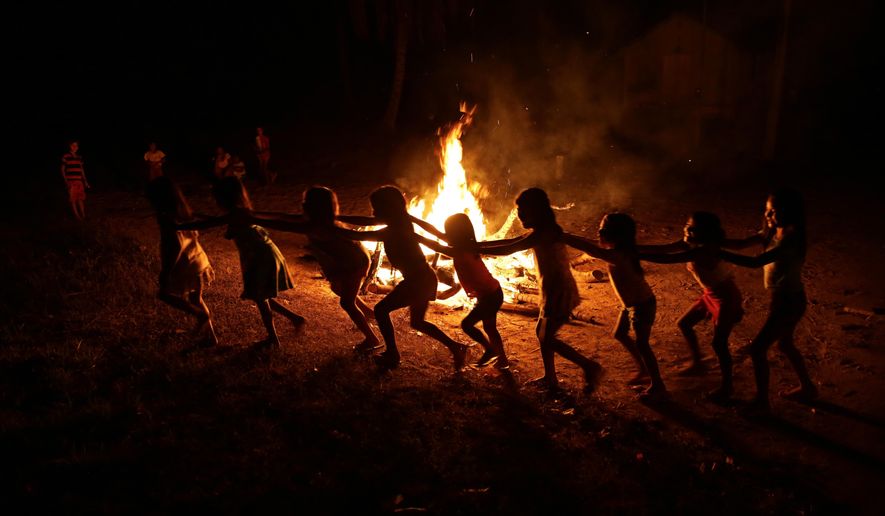ALTO RIO GUAMA INDIGENOUS TERRITORY, Brazil (AP) - A group of Tembé men armed with bows and shotguns arrived on motorcycles at the wooden gate blocking access to their villages in Brazil’s Amazon. One of them removed the padlock and slipped the chain off the gate.
“You are invited,” 33-year-old Regis Tufo Moreira Tembé said to a visitor. “What we are doing is for everyone, and for our good.”
The gate has seldom swung open since March, which helps to explain why the Tembé have gone six months without a single confirmed coronavirus infection. To celebrate that milestone, they were preparing a festival and invited an Associated Press photographer to observe.
The Tembé are the western branch of the Tenetehara ethnicity, located in the Alto Rio Guama Indigenous territory on the western edge of Para state. The virus has infiltrated the lands of dozens of Indigenous groups after they came to nearby cities to trade, buy staples and collect emergency welfare payments from the government.
The hundreds of Tembé people of the Cajueiro, Tekohaw and Canindé villages locked their gate and allowed people out only in case of emergency, while restricting entry to agents from the federal Indigenous health care provider, SESAI. Now, after the number of daily COVID-19 cases and deaths in Para has finally plunged, the Tembé have begun believing they will emerge from the pandemic unscathed.
“We didn’t go to the city, we didn’t go to other villages. We remained in quarantine. We got through, we are still getting through,” said Sérgio Muxi Tembé, the leader of the Tekohow village. “We are doing a small commemoration because of that, and it’s because of that we are happy that today we do not have any cases.”
Late afternoon on Sept. 9, the women of Tekohow gathered inside the communal kitchen to prepare a feast with giant pots of manioc and rice, plus roasted tucunare fish wrapped in banana leaves. At the very start of the epidemic, women from the three villages formed councils and visited residents at their board-and-batten homes to educate them about the peril of COVID-19 and how it is transmitted.
“We decided to create the group to give more orientation to the families because, even with the speech from the health technicians, people continued leaving,” Sandra Tembé, a 48-year-old teacher of the native language, said in an interview. “At the start, it was very difficult for us because there were families who we arrived to orient who didn’t want to agree, and said, ‘Why are you saying that? Why stay in isolation?’ That moment was very critical.”
She is thankful they listened, and that her people haven’t suffered like other ethnicities. The tally from Indigenous organization APIB, which includes health ministry figures and information from local leaders, shows there have been 31,306 confirmed coronavirus infections and 793 deaths among Indigenous people. It has infected members from 158 ethnicities, 60% of those found in Brazil, according to the Socio-Environmental Institute, an Indigenous advocacy group.
The Tembé also relied on a traditional herbal brew to shore up the health of the weak and elderly, according to Paulo Sergio Tembé, 50. Inside his home, he withdrew from a handmade basket the ingredients for the concoction and displayed them one by one.
As the sun went down, Tekohaw’s leader, Sérgio Muxi, stood chanting with an elder by two bonfires in front of the thatch-roofed meeting house; they cheered the Tembé resilience in the face of COVID-19 and offered their thanks in the native language, Sérgio Muxi explained later. Eventually, other members of the village joined in the singing, with others dancing. A line of children paraded with their hands on each others’ shoulders.
The next morning, the people awoke and began donning traditional feather headdresses and painting their bodies. Two marching groups converged at the site of the prior night’s bonfire, where they danced to the rhythm of traditional maracas played by the village’s leader and elders. The celebration continued for two hours before finally quieting, and the villagers returned to their homes, fields and forest to resume their daily lives.




Please read our comment policy before commenting.